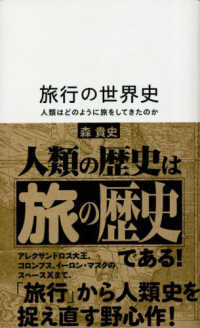- ホーム
- > 洋書
- > 英文書
- > History / World
Full Description
This book brings together a trail blazing collection of music scholars to explore the intersections, frictions, and resonances between nineteenth-century American music and history.
In the nineteenth-century United States, music was everywhere: from places of worship to the workplace, the parlor, the stage, and the street. Music accompanied paths of reform, supported both radical and conservative agendas, and helped Americans of all kinds to express patriotism, identity and resistance. The chapters in this volume unsettle longstanding assumptions about the types of music that were important to nineteenth-century Americans, where that music was performed, why, and for whom. And they underline the ability of music and musical practices to shed new light on questions of race, class, gender, and memorialization in the United States across the long nineteenth century. The volume offers insights for how and why to integrate nineteenth-century American music into history classrooms and highlights the need to embrace the challenge of interdisciplinary work to realize its greatest benefits.
This book will be relevant for students and researchers of American music history, cultural studies, and interdisciplinary historical analysis. The chapters in this book were originally published as a special issue of American Nineteenth Century History.
Contents
Introduction: Music in American nineteenth-century history 1. Black women and the cultural performance of music in mid-nineteenth century Natchez 2. Singers and managers: women and the operatic stage in late nineteenth-century America 3. From obscurity to national icon: memorializing Stephen C. Foster in the 1890s 4. We have fed you all 1000 years: nineteenth-century radical song and the rise of North American labor 5. Teaching nineteenth-century American history with music: leveraging the possibilities through technology and Universal Design for Learning Afterword








